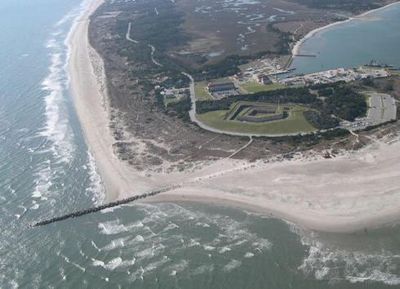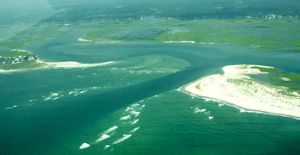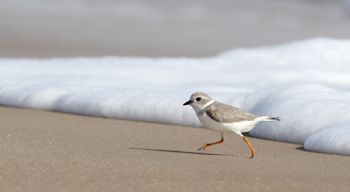WILMINGTON — Federal and state agencies have asked for more study of a proposed terminal groin project on Figure Eight Island, and one federal agency has recommended that the proposal be denied until more information is provided.
The proposal also has run into opposition from some property owners who say they will not give permission for their land to be used. That permission would likely be needed for the project the island homeowners association would prefer to build, but proponents say other options are possible that would not require the properties in question.
Supporter Spotlight
 Terminal groins, like this one at Fort Macon State Park in Atlantic Beach, are built perpendicular to shore at inlets to control erosion, but their environmental effects are often unpredictable. Photo: Program for the Study of Developed Shorelines, Western Carolina University. |
The Figure “8” Beach Homeowners Association wants to control erosion near the northern tip of the island, and the group’s preferred option calls for building a small jetty, or terminal groin, and a seawall. It would be the first project permitted under a new law passed by the N.C. General Assembly last year. Hard-structures like jetties and groins had been illegal on N.C. beaches, but the law allows up to four groins at inlets. The association, which represents homeowners on the privately developed island near Wilmington, lobbied the legislature to change the law.
Such structures are commonly made by piling rocks in a long line perpendicular to shore. In effect, the groins are sand traps that proponents say would slow erosion on parts of the island. The structures had been banned on N.C. beaches because they tend to increase erosion elsewhere on the beach and their effects are difficult to predict. The association, though, expects some sand to continue to flow around the groin and through gaps in the rocks.
The intent of the groin, along with the addition of sand to some island beaches, is to control shoreline erosion near the northern end of the island and to protect waterfront houses. The association submitted a draft environmental impact statement to the Wilmington office of the U.S. Army Corps of Engineers as part of a required review of the project, and the corps released that document earlier this year.
The U.S. Fish and Wildlife Service, the National Marine Fisheries Service and the N.C. Division of Marine Fisheries all reviewed the draft environmental study. The document examines several alternatives, but the preferred option calls for building the terminal groin extending 700 feet into the ocean near Rich Inlet at the northeast corner of the island. To anchor the groin, a seawall would extend several hundred feet onto the back side of island to ensure that erosion does not continue on the landward side.
Both fishery agencies expressed concern for the health of the inlet and called for more study of the area before a permit is granted. Fish and Wildlife went further, recommending denial of the project as described because the environmental review did not adequately address potential impacts to endangered species and sensitive habitats. The agency also offered to help the homeowners association in producing a more thorough environmental review.
Supporter Spotlight
The homeowners association will need federal and state permits for the project, and the Corps of Engineers is typically the first stop in such a process. David Kellam, director of the homeowners association, declined to discuss specific comments, saying he preferred to wait for the corps to provide feedback and instruction on how to move forward.
<p”>“We’re very early in the process,” Kellam said. “Now is not the time to (discuss specific comments).”
The review process can require an environmental impact statement to be reworked, and the document released earlier this year is a “draft,” or preliminary version. The corps could approve the document as is, require revisions or reject the document outright, but Mickey Sugg, the Corps official overseeing the process, declined to provide a timeline. He said the comments are being reviewed as part of the formal process and that a Corps decision would be forthcoming.
Kellam said it is certainly possible that the Corps will request additional work on the document. “I think the Corps will ask the contractor to address any of the relevant comments pertaining to Rich’s Inlet,” he said.
Those concerns may include a general rewrite of the document.
 Federal agencies expressed concerns that the draft study of the proposed groin at Figure Eight Island doesn’t adequately address possible effects on essential wildlife habitat at Rich Inlet. Photo: Army Corps of Engineers. |
“In general, the DEIS (draft environmental impact statement) appears disorganized, and specific information on the various alternatives proposed and project impacts was hard to find,” the Fish and Wildlife comments state. “Specific information on the alternatives was spread throughout the large document, which made it difficult to develop a cohesive picture of the alternatives and potential impacts.”
The study is required by federal law in projects like the one the homeowners association is considering. Its purpose is to provide the sort of cohesive picture that, according to Fish and Wildlife, is elusive in the Figure Eight document. The agency also states that economic data in the draft study used for cost-benefit analyses appears flawed. The economic data appears to overstate the potential economic threat to the island, the agency states in its comments.
The environmental assessment also appears to contradict itself and in doing so may run afoul of state law, according to Fish and Wildlife. That law requires that “nonstructural approaches to erosion control” first be found “impractical” before a groin can be considered. The draft study examines several options for controlling erosion, and the document states early on that a nonstructural option, managing Rich Inlet and adding sand to eroding beaches, is sufficient. The environmental assessment needs to deal with this apparent contradiction, the Fish and Wildlife comments state
Nonprofit environmental groups and individuals also submitted comments on the environmental review, and some of those comments are excoriating. However, not all comments were available. The Corps has not publicly released comments; the documents reviewed in this article were provided by agencies and individuals involved. Sugg said a large number of comments had been received and that that he could not say whether the lion’s share of the comments was in favor or against the project.
One of the nonprofit groups commenting on the document is Audubon North Carolina, a wildlife conservation group focusing on the needs of birds. The group challenges large swaths of the data presented in the document as incomplete, incorrect and, in some cases, misleading. The organization also expresses adamant opposition to any erosion control project that would affect habitats near Rich Inlet. The area is important to the health of several endangered species and should be safeguarded, Audubon asserts in its letter to the Corps. The environmental impact statement, which by law, is supposed to examine impacts to such sensitive environments, fails on many counts, Audubon asserts.
The draft study’s shortcomings are numerous, Audubon wrote. The organization said the study fails to adequately describe the affected environment and assess the environmental consequences; fails to consider the scientific data that exists and is available; fails to consider the impacts to federal and state listed species and high-priority species; omits key bird species considered threatened by the state; fails to consider the impacts on habitats for shorebirds, waterbirds and other wildlife; ignores the pertinent recommendations of leading scientists; fails to objectively consider impacts and alternatives; fails to consider indirect and cumulative impacts; presents dubious models based on old data that could not predict the present orientation of the inlet and are of questionable use in predicting the future orientation of the inlet in response to the terminal groin construction; and contains an “extraordinary number” of factual errors and omissions.
 Audubon North Carolina worries about the proposed groin’s effects on rare birds like the piping plover. |
“Some of these omissions are so systemic and egregious as to give the impression that the DEIS was drafted in order to arrive at the conclusions desired by the applicant rather than to report the full and objective consideration of and impacts of reasonable alternatives,” Audubon wrote. “In its current state, the DEIS should not be accepted by the permitting agencies and returned for major corrections and revisions to address these crucial flaws.”
The old data referenced in Audubon’s comments includes a study that predicted continued erosion on Figure Eight Island, erosion that would threaten homes. However, sand has been building up on the beach in front of those homes in recent years, and several commenters asserted that these conditions indicate that an erosion control project is unnecessary. Additionally, Audubon takes issue with the document’s examination of a particular endangered bird.
<p”>“One of the most objectionable aspects of the DEIS is its deliberate distortion of impacts to shorebirds, particularly the piping plover, through its selective citation and sourcing of scientific literature and federal shorebird recovery plans and reports,” the Audubon comments state.
The plover is an endangered shorebird that is found on parts of the N.C. coast year-round. The environmental review claims that the proposed terminal groin would be beneficial because it would create more sand dunes for the birds, but that assertion is challenged both by Audubon and the Fish and Wildlife Service. Audubon asserts that the dunes created by groins often have too much vegetation to accommodate the nesting needs of birds like the piping plover, and Fish and Wildlife states that the draft study does not provide sufficient discussion of potential effects to the nesting and foraging spaces that such birds need.
Another nonprofit commenting on the document, the Southern Environmental Law Center, takes issue with the way the process has moved forward. Like Audubon, the group challenges the data in the document, but it also asserts that the homeowners association needs to secure access to the property needed before the process should move forward.
One reason for the tug-of-war over property access stems from the limited power wielded by the homeowners association. Local governments, for instance, often submit and complete environmental reviews before access rights are secured. Access is not an issue in such cases because, if needed, the towns could condemn any private property required and use it whether the owner wants the terminal groin or not. On Figure Eight Island, the homeowners association has no such powers and would need permission of a property owner or would need to buy property outright. Even so, private applicants may move forward with the environmental review before securing property rights, a Corps official said.
Several groups commenting on the document banded together and asked the corps to suspend any further action on the environmental review and require the homeowners association to essentially start over. The groups, which include N.C. Audubon, Environmental Defense Fund, Penderwatch & Conservancy, Western Carolina University’s Program for the Study of Developed Shorelines, Southern Environmental Law Center and the N.C. Coastal Federation, made four claims in the request:
- No property is imminently threatened and therefore the preferred alternative is not allowed by state law.
- The project has not been adequately defined to trigger a formal review and the project’s scope, purpose and need have been drastically changed without any public notice.
- Flaws in the draft study make it useless. While it might be possible to correct inaccuracies, omissions, content and the disorganized state of the document, making the DEIS a truly independent and unbiased analysis of alternatives will be impossible.
- A complete permit application has never been submitted. In fact, because the applicant has not secured the necessary private property rights to build its preferred alternative a complete application is not even possible under both federal and state permit application rules.
The Corps office in Wilmington disagreed with the assertions and in a response issued Friday stated that the current environmental review will continue. Corps officials in Wilmington and Washington said an applicant does not need to secure property rights prior to the evaluation of an environmental impact statement.
“You can absolutely submit your application even if you don’t have access,” said Erin Hess, a Corps official in the agency’s Washington headquarters. “We get that a lot.”
No permit would be given if an applicant could not get access to needed property, but that is a matter separate from the review of environmental impacts, Hess said. The Wilmington corps office echoed that assessment. The organizations asking for the Corps to suspend work assert that the review would be a waste of time and taxpayer money if access is not secured first.
Kellam of the homeowners association said one reason for not seeking access involves location. The exact site of any structure has not been established, and that the environmental review process will guide the homeowners association in deciding what and where to build, he said.
The proposed project also has raised some opposition among homeowners. The preferred option described in the draft study has given some property owners the impression that the groin could limit their access to the water, prove to be an eyesore, reduce property values and perhaps interfere with insurance. Alan Goldenberg, a property owner who lives on the northeast end of the island, said that he believes his property would be needed for the terminal groin as described in the environmental review. He said he and more than five other property owners are opposed to the project unless the homeowners association can prove to them that there will be no negative effects to their land. Other property owners confirmed Goldenberg’s assertion.
“I am opposed based on the present presentation of the groin location,” Goldenberg said.
Goldenberg also said that property owners were given the impression early on that the terminal groin would be built in waters near Rich Inlet, away from their land. That option would be acceptable, Goldenberg said, but it is not what is described in the environmental review.
Other homeowners support the project because they want to safeguard their property against potential erosion.
“As far as I’m concerned, it’s a pretty good idea,” said homeowner George Denby. “It’s the most promising idea of any I’ve come across.”
Denby also said that he supports Audubon, and that he believes the terminal groin would be beneficial to the natural environment as well. He acknowledged that, in recent years, sand has been building up in front of the houses thought to be in danger. However, the terminal groin is still needed, he said, to ensure long-term safety.
“It’s a benefit to the entire community,” Denby said.
Still other property owners are opposed to the terminal groin at a conceptual level. John Stanback said he thinks people who willingly bought beachfront property should not get unlimited access to erosion control measures.
“I have the greatest sympathy for people wanting to protect their homes,” Stanback said. “Everyone knows this is a North Carolina barrier island made of sand, and they move.”
Kellam said he understands homeowner objections and that he is committed to providing information to allay peoples’ concerns.
“There are some homeowners who have reservations, and I don’t blame them,” Kellam said. “I do believe that all the hurdles will be overcome with time and with correct information being disseminated to everyone.”







